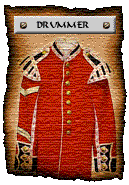
The red coats with white ‘drummers braid’ adorned with red crowns signify that the owner is a drummer, fifer or bugler in the infantry. Today, some people may question the need for these company musicians, however, they were critical for battlefield communication. Vocal commands were totally useless for controlling large bodies of troops in the noise of battle. Consequently, most commands were given by bugle or drum during battle. During a normal day in garrison, drum, fife, and bugle calls were also used to announce each aspect of daily routine such as reveille, dinner, fatigue, parade, drill periods, retreat, etc. These instruments were the army’s form of communication.
 Each company (approximately 100 soldiers) in a line infantry
battalion (5 to 10 companies) had one drummer and one fifer in its establishment. Highland
regiments had one drummer per company, while rifle regiments only had buglers. When all
the company’s fifers and drummers were grouped together under the direction of the
drum major, they were collectively known as the Drums. Extra pay was given to these men as
they were responsible for the upkeep of their instruments.
Each company (approximately 100 soldiers) in a line infantry
battalion (5 to 10 companies) had one drummer and one fifer in its establishment. Highland
regiments had one drummer per company, while rifle regiments only had buglers. When all
the company’s fifers and drummers were grouped together under the direction of the
drum major, they were collectively known as the Drums. Extra pay was given to these men as
they were responsible for the upkeep of their instruments.
Many regiments had a regimental band as well as a Corps of Drums. The instruments of the band were mostly woodwind and brass, with the musicians and band leader being professional musicians. Bands were used for ceremonial duties, the men wearing white tunics. The band was maintained by officers paying a yearly fee towards it. Since the band was a matter of prestige, it was often expanded beyond what the Army was prepared to support. Officers would pay for each bandsman above the official establishment.
Each regiment had its own special music for marching past on review, or lamenting the dead. There was even one tune called the "Rouge's March" which was played when undesirables were dismissed from a regiment.
In the 1800s, military bands were extremely important to the social life of Kingston. They were, in effect, the only established musical performing group and therefore were in constant demand. When a band appeared to play locally, whether to play a concert of Mozart, or supply music for public skating in front of City Hall, it was by the "kind permission" of the commanding officer.
Next Page: The History of Uniforms...
![]()